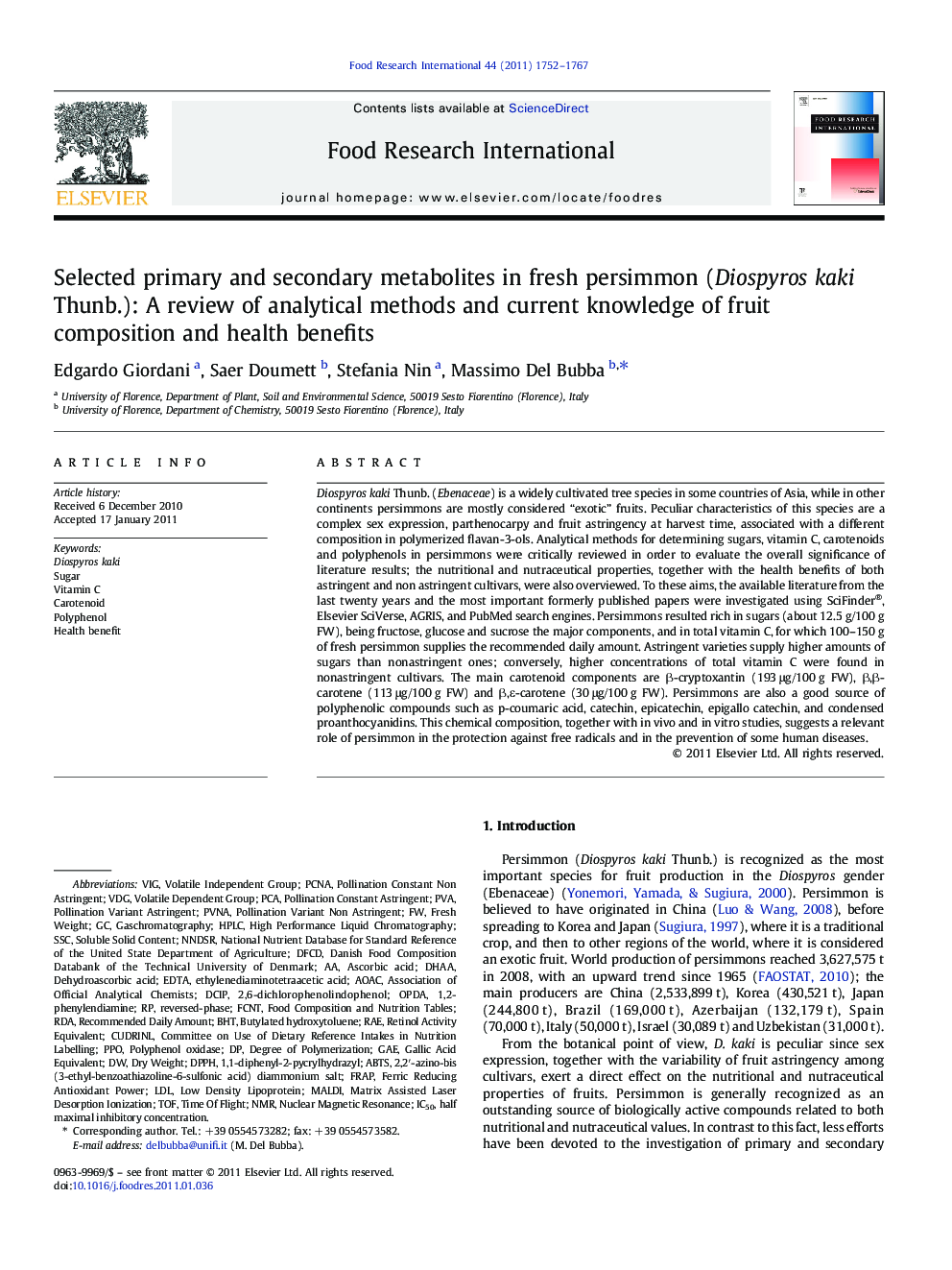| کد مقاله | کد نشریه | سال انتشار | مقاله انگلیسی | نسخه تمام متن |
|---|---|---|---|---|
| 6399473 | 1330704 | 2011 | 16 صفحه PDF | دانلود رایگان |
عنوان انگلیسی مقاله ISI
Selected primary and secondary metabolites in fresh persimmon (Diospyros kaki Thunb.): A review of analytical methods and current knowledge of fruit composition and health benefits
دانلود مقاله + سفارش ترجمه
دانلود مقاله ISI انگلیسی
رایگان برای ایرانیان
کلمات کلیدی
PVAOPDATOFDHAAGAEPPOAOACRAEDiospyros kakiDCIPFRAPSSCIC50RDAVIGABTSPCNAGaschromatographyvDGBHTDPPHnuclear magnetic resonance - رزونانس مغناطیسی هستهای2,6-dichlorophenolindophenol - 2،6-dichlorophenolindophenolPCA - PCAAscorbic acid - آسکوربیک اسیدEDTA - اتیلن دی آمین تترا استیک اسید ethylenediaminotetraacetic acid - اتیلنیدامینوترواتیک اسیدDehydroascorbic acid - اسید Dehydroascorbicassociation of official analytical chemists - انجمن متخصصان تحلیلی رسمیNMR - تشدید مغناطیسی هستهای degree of polymerization - درجه پلیمریزاسیونtime of flight - زمان پروازReversed-phase - فاز معکوسSugar - قندlow density lipoprotein - لیپوپروتئین چگالی کمLDL - لیپوپروتئین کم چگالی(کلسترول بد)matrix assisted laser desorption ionization - ماتریکس یونیزاسیون لیزر را پشتیبانی می کندMALDI - مالدیSoluble solid content - محتوای جامد محلولHealth benefit - مزیت سلامتیGallic acid equivalent - معادل اسید گالیکretinol activity equivalent - معادل فعالیت رتینولhalf maximal inhibitory concentration - نیمه حداکثر غلظت مهاریbutylated hydroxytoluene - هیدروکسی تورولین باتلاقیfresh weight - وزن ترdry weight - وزن خشکvitamin C - ویتامین سیPolyphenol - پلی فنلPolyphenol oxidase - پلی فنول اکسیدازCarotenoid - کاروتنوئیدferric reducing antioxidant power - کاهش قدرت آنتی اکسیدان آهنhigh performance liquid chromatography - کروماتوگرافی مایع با کارایی بالاHPLC - کروماتوگرافی مایعی کارا
موضوعات مرتبط
علوم زیستی و بیوفناوری
علوم کشاورزی و بیولوژیک
دانش تغذیه
پیش نمایش صفحه اول مقاله

چکیده انگلیسی
Diospyros kaki Thunb. (Ebenaceae) is a widely cultivated tree species in some countries of Asia, while in other continents persimmons are mostly considered “exotic” fruits. Peculiar characteristics of this species are a complex sex expression, parthenocarpy and fruit astringency at harvest time, associated with a different composition in polymerized flavan-3-ols. Analytical methods for determining sugars, vitamin C, carotenoids and polyphenols in persimmons were critically reviewed in order to evaluate the overall significance of literature results; the nutritional and nutraceutical properties, together with the health benefits of both astringent and non astringent cultivars, were also overviewed. To these aims, the available literature from the last twenty years and the most important formerly published papers were investigated using SciFinder®, Elsevier SciVerse, AGRIS, and PubMed search engines. Persimmons resulted rich in sugars (about 12.5 g/100 g FW), being fructose, glucose and sucrose the major components, and in total vitamin C, for which 100-150 g of fresh persimmon supplies the recommended daily amount. Astringent varieties supply higher amounts of sugars than nonastringent ones; conversely, higher concentrations of total vitamin C were found in nonastringent cultivars. The main carotenoid components are β-cryptoxantin (193 μg/100 g FW), β,β-carotene (113 μg/100 g FW) and β,ε-carotene (30 μg/100 g FW). Persimmons are also a good source of polyphenolic compounds such as p-coumaric acid, catechin, epicatechin, epigallo catechin, and condensed proanthocyanidins. This chemical composition, together with in vivo and in vitro studies, suggests a relevant role of persimmon in the protection against free radicals and in the prevention of some human diseases.
ناشر
Database: Elsevier - ScienceDirect (ساینس دایرکت)
Journal: Food Research International - Volume 44, Issue 7, August 2011, Pages 1752-1767
Journal: Food Research International - Volume 44, Issue 7, August 2011, Pages 1752-1767
نویسندگان
Edgardo Giordani, Saer Doumett, Stefania Nin, Massimo Del Bubba,